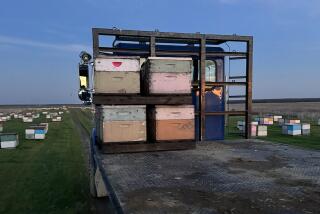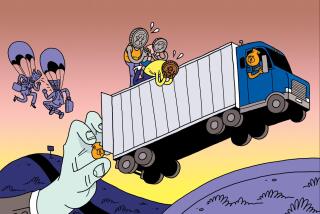Antler Theft Causes Pointed 4-Year Dispute
- Share via
FALL RIVER MILLS, Calif. — It was only a set of deer antlers. But to Craig Knoch, a fifth-generation rancher in this peaceful valley of hay farms and range land, the broad and beautiful rack was more than special. This was an heirloom, a relative’s gift to prize for life.
It was only a set of antlers. But to Clint Heiber, wealthy businessman and trophy hunter, those remarkable mule deer antlers were irresistible, worthy of a spot among his vast collection of mounted animal heads.
So it was that rancher and trophy hunter came to clash, in life and in court, over a pair of antlers. The duel, simmering for four years, finally led to felony charges against Heiber.
To urbanites this episode may sound bizarre, the stuff of a backwater crime blotter. But in California’s rural outback, where hunting is as accepted a part of sporting life as a trip to the gym is in Westwood, the notion of one man stealing another’s prized rack of deer antlers borders on blasphemy.
“This sort of case doesn’t have a whole lot to do with hunting,” said Paul Wertz, a state Fish and Game Department spokesman. “It has to do with conspicuous consumption, with the peculiar need of some people to have the biggest yacht or the best-looking woman on their arm or the most spectacular deer mount on their wall.”
Clint Heiber, 51, is big stuff around Red Bluff, a small city on the north end of the Sacramento Valley. His family runs an irrigation company that sells water pipes and other agricultural accouterments in Northern California, Oregon and Nevada.
The business pays the bills and built the pool behind his home, but hunting is what burns in Heiber.
His sprawling house is like a museum, a hunting lodge. Mounted deer, elk and caribou stare down from the high walls, antlers jutting, hides stretched lifelike over shaped cores of Styrofoam. A fully preserved grizzly bear climbs a faux granite wall, frozen in time with a sheep in its grasp. About 200 animals are on display.
Several are in the record book, which scores an animal’s worth based on the span and volume of antlers or skull. Heiber also is featured in half a dozen trophy hunting videos marketed by a Utah outfitter.
Craig Knoch, 33, looked up to Heiber as a sportsman. Knoch is himself a hunter of note in Fall River Valley, a place of bucolic beauty where backwoods skill is much admired though generally expected. Heiber had been making sales calls for two decades at Knoch Ranch, where cattle and hay share 3,000 acres. Knoch’s father considered Heiber a friend.
The antlers were a fluke. They were found in 1984, shed in the spring by a massive buck. Relegated to a spot in the garage of Knoch’s cousin, they collected cobwebs for a decade.
But even to the uneducated eye these antlers are magnificent: 3 feet wide, massive as gnarled branches of oak. While most deer antlers spread skyward, these points arch up and down, a distinctive trait prized in the hunting world. They represent “the buck of a lifetime for any hunter,” said one wildlife expert, capable of fetching $10,000 at auction.
Knoch got them in late 1993 with a promise: Mount them properly and keep them in the family.
Frustrated in his attempts to find a taxidermist he could trust, Knoch asked Heiber’s advice, bringing the rack by the irrigation firm.
Heiber was wowed. He wanted to buy them, Knoch would later say in court, offering first $1,000, then $2,500, then a guided hunting trip worth $10,000. The rancher refused.
“You don’t understand, Clint,” Knoch replied. “These are not for sale at any price.”
Eventually, a deal was struck. As Knoch tells it, Heiber was to send the rack to his taxidermist in Montana and have them mounted for free. In exchange, a duplicate set of antlers would be cast for Heiber to display. Both men could enjoy the magnificent buck. They shook on it.
It was the start of trouble.
In the beginning, Knoch would drop by to visit Heiber every six months or so and inquire about the antlers. The conversations were friendly, Knoch testified, but Heiber would offer some excuse for the delays.
As the months stretched to years, Knoch grew more irked. Heiber tried to smooth it over. In late 1995, he paid for Knoch to travel to the Southwest to scout for bucks in preparation for a big hunt. And a few months later, he hired Knoch as a sales representative at the irrigation company.
But Knoch quit after three months. His boss, Knoch said, wanted him to be a “runaround hunting guide” more than a salesman.
Heiber did not return calls from The Times for comment.
Their relationship soured after that. In March 1997, Knoch drove the two hours from Fall River to confront Heiber at his Red Bluff office.
As Knoch recalled in court, Heiber roared at him, furious that he quit after the company paid for his training. Knoch growled back, saying the job had nothing to do with anything. He wanted his antlers.
Heiber allegedly told Knoch the only way the originals would be returned was for a payment of $5,000. If he complained to anyone, the antlers would be destroyed, Knoch said Heiber told him.
At that point, the rancher turned into a detective. Knoch drove to Whitehall, Mont., to find Heiber’s taxidermist, Dan McKenna.
Hiding his true intentions, Knoch lugged along another set of shed antlers to show the taxidermist. Had he done any similar work? Sure, McKenna answered. He pulled out a photograph. There was no mistake: It was Knoch’s missing antlers, beautifully mounted. They had been shipped, McKenna added, to a client in Red Bluff a couple years earlier.
Back home, Knoch stewed for months, then complained to the state Fish and Game Department, which launched an investigation in 1998. Three months later, wardens searched Heiber’s house, finding the missing mule deer antlers on a wall. The trophy hunter was arrested on charges of theft and extortion.
Heiber told investigators that Knoch had sold him the originals, though he couldn’t remember for how much. Knoch, he said, was supposed to get the duplicate set.
At the preliminary hearing in January, Heiber’s attorney argued that criminal charges were ludicrous, that the dispute should be slugged out in civil court. Heiber had felt betrayed after Knoch quit and believed the ranching scion should pay for the taxidermy, attorney Joe Gazzigli said. He noted that there never was a written agreement.
Brian Ledford, a Shasta deputy district attorney, countered that Heiber demonstrated a deceptive pattern, putting Knoch off at each step to keep the antlers. The two men had a deal, Ledford said, and Heiber broke it.
“These people are ranchers and farmers,” he said. “Their word is their bond.”
In October, Heiber pleaded no contest to a misdemeanor count of theft. A judge ordered him to perform 400 hours of community service, pay $7,500 in fines and reimburse the costs of the investigation, $27,000 in all. He also was stripped of his rights to hunt in the United States and Canada for the next five years.
The notorious rack now is fixed to a wall in Knoch’s living room. And he figures Heiber got what he deserved.
“I just wanted my property back,” Knoch said. “I had to do what I had to do.”
More to Read
Sign up for Essential California
The most important California stories and recommendations in your inbox every morning.
You may occasionally receive promotional content from the Los Angeles Times.













